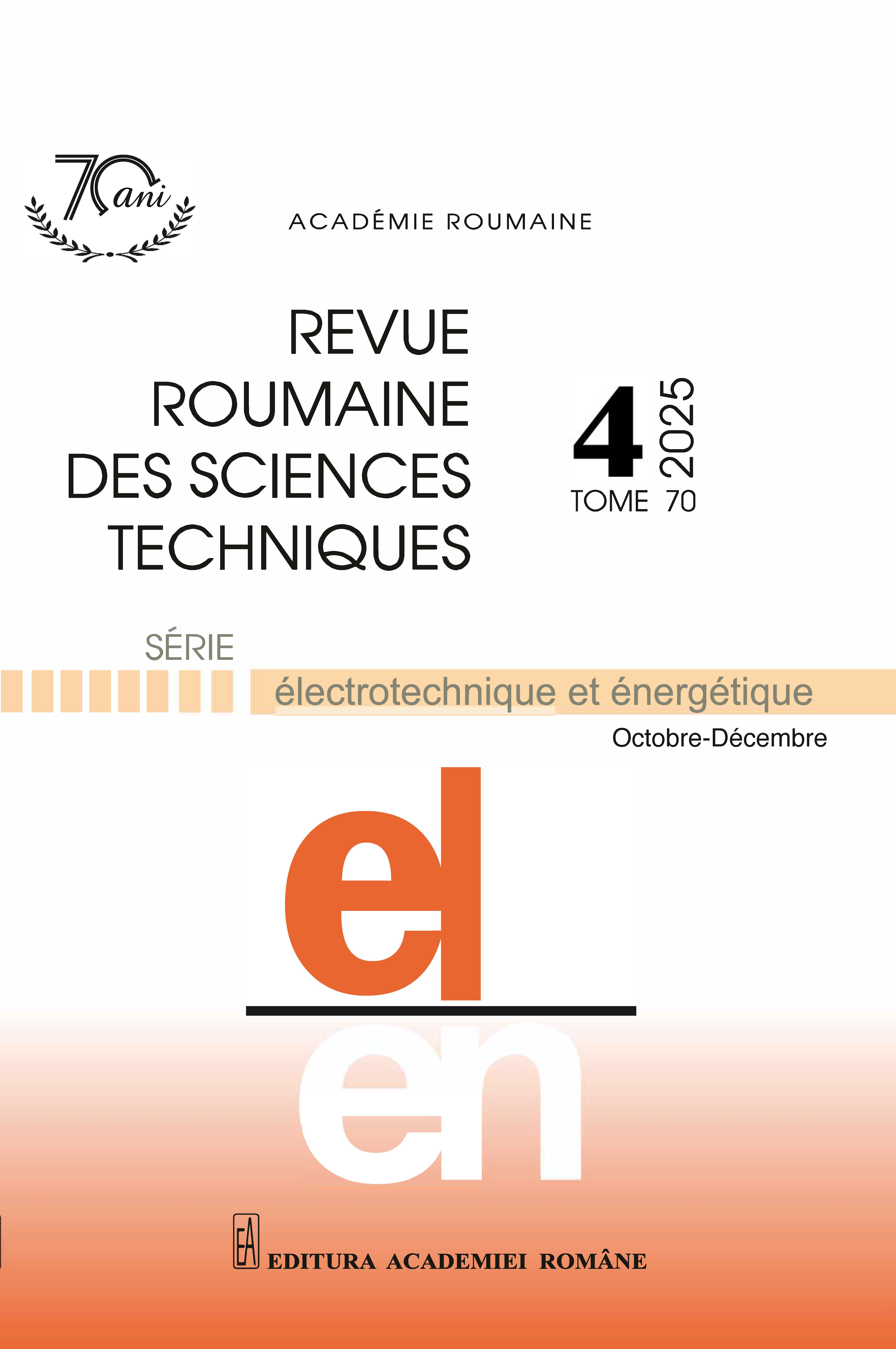ALGORITHME DYNAMIQUE EN SPIRALE AMÉLIORÉ AVEC APPLICATION À L'IDENTIFICATION DES PARAMÈTRES D'UN MOTEUR À INDUCTION
DOI :
https://doi.org/10.59277/RRST-EE.2025.4.2Mots-clés :
Algorithme dynamique en spirale, Méta-heuristique, Machine d'induction, Identification, Rayon de spirale, Angle de rotationRésumé
L'algorithme dynamique en spirale (SDA) est une métaheuristique caractérisée par le réglage de paramètres, tels que le rayon de la spirale et l'angle de rotation. L'inconvénient de toutes les méthodes métaheuristiques est la convergence prématurée, qui survient lorsqu'un compromis entre exploitation et exploration n'est pas maintenu. Le SDA offre une bonne phase d'exploitation, car tous les points convergent vers la meilleure solution. Mais la phase d'exploration est médiocre lorsque les paramètres de la spirale sont maintenus constantes tout au long du processus de recherche. Afin d'améliorer les performances du SDA et de prévenir la convergence prématurée, cet article propose un SDA amélioré dans lequel les paramètres varient simultanément selon des fonctions non linéaires. L'efficacité de l'algorithme SDA amélioré (ESDA) a été démontrée par l'identification des paramètres électriques et mécaniques d'un moteur à induction (IM). Ceci est réalisé à l'aide de la méthode du modèle de référence, dans laquelle les paramètres estimés correspondent au minimum de la fonction d'objectif. Une comparaison est établie entre l'ESDA, les SDA, l'algorithme génétique (GA) et l'optimisation par essaim particulaire (PSO). Le programme développé et l'approche d'estimation sont testés à l'aide de données simulées et mesurées provenant d'un IM (1,5 kW).
Références
(1) Hanif Halim, I. Ismail, and D. Swagatam, Performance assessment of the metaheuristic optimization algorithms: an exhaustive review, Artificial Intelligence Review, 54, 3, pp. 2323–2409 (2021).
(2) K. Satnam, K.A. Lalit, A.L. Sangal, and D. Gauravn, Tunicate swarm algorithm: a new bio-inspired based metaheuristic paradigm for global optimization, Engineering Applications of Artificial Intelligence, 90 (2020).
(3) S. Ekinci, D. Izci, and L. Abualigah, A novel balanced Aquila optimizer using random learning and Nelder–Mead simplex search mechanisms for air–fuel ratio system control, J Braz. Soc. Mech. Sci. Eng., 45, 68 (2023).
(4) D. Izci, B. Hekimoglu, and S. Ekinci, A new artificial ecosystem-based optimization integrated with Nelder-Mead method for PID controller design of buck converter, Alexandria Engineering Journal, 61, pp. 2030–2044 (2022).
(5) E. Boudissa, F. Habbi, N.E.H. Gabour, and M. Bounekhla, A new dynamic genetic selection algorithm: application to induction machine identification, Rev. Roum. Sci. Techn. – Électrotechn. Et Énerg., 66, 3, pp. 145–151 (2021).
(6) D. Naas, E. Boudissa, M. Bounekhla, and I. Dif, Firefly algorithm improvement with application to induction machine, Rev. Roum. Sci. Techn. – Électrotechn. Et Énerg., 65, 1, pp. 35–40 (2020).
(7) A.S.A. Bayoumi, R.A. El Sehiemy, and A. Abaza, Effective PV parameter estimation algorithm based on marine predators optimizer considering normal and low radiation operating conditions, Arabian Journal for Science and Engineering (2021).
(8) A.A. Mekki, A. Kansab, M. Matallah, and M. Feliachi, Optimization of the inductor of an induction cooking system using particle swarm optimization method and fuzzy logic controller, Rev. Roum. Sci. Techn. – Électrotechn. Et Énerg., 65, 3–4, pp. 185–190 (2020).
(9) X. Jianzhong and F. YanBisht, Effective PV parameter estimation algorithm based on marine predators optimizer considering normal and low radiation operating conditions, Arabian Journal for Science and Engineering (2019).
(10) K. Tamura and K. Yasuda, Primary study of spiral dynamics inspired optimization, IEEJ Trans Electric Electron Eng., 6, pp. 98–100 (2011).
(11) K. Tamura and K. Yasuda, Spiral dynamics inspired optimization, J Adv Comput Intell Inform, 15, 8, pp. 1116–1122 (2011).
(12) A.N.K. Nasir and M.O. Tokhi, Novel metaheuristic hybrid spiral-dynamic bacteria-chemotaxis algorithms for global optimisation, Applied Soft Computing, 27, pp. 357–375 (2015).
(13) E. Cuevas, A. Echavarría, and M.A. Ramírez-Ortegón, An optimization algorithm inspired by the States of Matter that improves the balance between exploration and exploitation, Applied Intelligence, 40, pp. 256–272 (2014).
(14) A.N.K. Nasir, M.O. Tokhi, N.M. Abd Ghani, and R.M.T. Raja Ismail, Novel adaptive spiral dynamics algorithms for global optimization, In Proceedings of the 2012 IEEE 11th International Conference on Cybernetic Intelligent Systems (CIS), Guildford, UK, pp. 99–104 (2012).
(15) A.N.K. Nasir, M.O. Tokhi, N.M. Abd Ghani, and M.A. Ahmad, A novel hybrid spiral-dynamics bacterial-foraging algorithm for global optimization with application to control design, In 2012 12th UK Workshop on Computational Intelligence (UKCI), pp. 1–7 (2012).
(16) M.R. Hashim and M.O. Tokhi, Chaotic spiral dynamic optimization algorithm, In 19th International Conference on Climbing and Walking Robots and the Support Technologies for Mobile Machines, London, UK, pp. 1–8 (2016).
(17) A.N.K. Nasir and M.O. Tokhi, An improved spiral dynamic optimization algorithm with engineering application, IEEE Trans. Syst. Man. Cybern. Syst., 45, pp. 943–954 (2015).
(18) A. Accetta, F. Alonge, M. Cirrincione, M. Pucci, and A. Sferlazza, Parameter identification of induction motor model by means of state space-vector model output error minimization, In XXI International Conference on Electrical Machines (ICEM), pp. 843–849 (2014).
(19) J.W. Rengifo-Santana, J. Benzaquen-Suñe, J.M. Aller-Castro, A.A. Bueno-Montilla, and A. Restrepo-Zambrano, Parameter estimation method for induction machines using instantaneous voltage and current measurements, Rev. Fac. Ing. Univ. Antioquia, 75, pp. 57–66 (2015).
(20) J. Chatelain, Machines électriques, In Traité d’Électricité, Vol. X, Lausanne, France: Presses Polytechniques Romandes (1983).
Téléchargements
Publiée
Numéro
Rubrique
Licence
(c) Copyright REVUE ROUMAINE DES SCIENCES TECHNIQUES — SÉRIE ÉLECTROTECHNIQUE ET ÉNERGÉTIQUE 2025

Ce travail est disponible sous licence Creative Commons Attribution - Pas d'Utilisation Commerciale - Pas de Modification 4.0 International.


